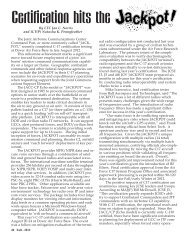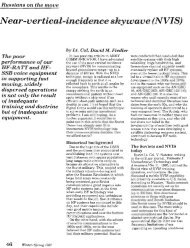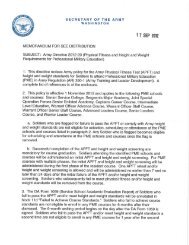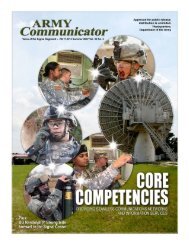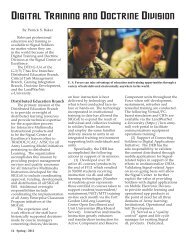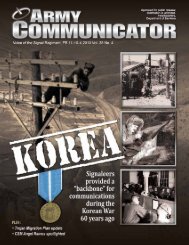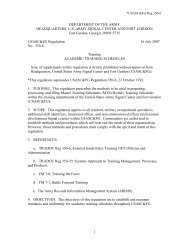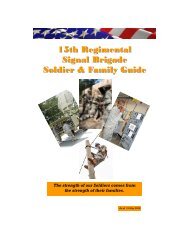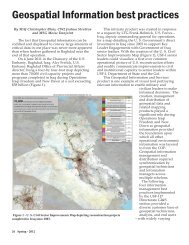AC Summer 08 WIN-T Online - United States Army Signal Center of ...
AC Summer 08 WIN-T Online - United States Army Signal Center of ...
AC Summer 08 WIN-T Online - United States Army Signal Center of ...
Create successful ePaper yourself
Turn your PDF publications into a flip-book with our unique Google optimized e-Paper software.
Fielding Process, the Single Interface<br />
to the Field portal, and the Battle<br />
Command as a Weapons System<br />
Initiative are three specific processes<br />
that have been stood up to manage<br />
these challenges and direct the<br />
implementation <strong>of</strong> tactical C3<br />
capabilities.<br />
USF is a five-phase process that<br />
manages the planning and implementation<br />
<strong>of</strong> fielding and reset for<br />
all major <strong>Army</strong> tactical command,<br />
control, communications, computers,<br />
intelligence, surveillance, and<br />
reconnaissance capabilities. The U.S.<br />
<strong>Army</strong> and, specifically, the organizations<br />
<strong>of</strong> the Communications Electronics<br />
Command Life Cycle Management<br />
Command, simultaneously<br />
provided warfighters with everything<br />
they need to perform their<br />
mission in combat through the phase<br />
<strong>of</strong> USF. This means providing the<br />
<strong>Army</strong> Battle Command Systems<br />
(ABCS 6.4), the communications<br />
systems, power, the network, and<br />
enablers all at the same time.<br />
The five USF phases are:<br />
1) Planning for fielding and<br />
engineering<br />
2) Fielding execution<br />
3) Supporting while deploying<br />
4) Supporting while deployed<br />
5) Resetting to headquarters<br />
The implementation <strong>of</strong> the<br />
<strong>Army</strong> Force Generation model<br />
provides a structured progression <strong>of</strong><br />
increased unit readiness over time<br />
resulting in recurring periods <strong>of</strong><br />
availability <strong>of</strong> trained, ready, and<br />
cohesive units. Battle update<br />
briefings held on a bi-weekly basis<br />
coordinate the C3 leads <strong>of</strong> the USF<br />
process and open lines <strong>of</strong> communication<br />
with <strong>Army</strong> Field Support<br />
brigade commanders, engineers and<br />
U.S. <strong>Army</strong> leadership.<br />
The SIF initiative was stood up<br />
to provide 24/7 reach back support<br />
for warfighters and forward support<br />
personnel through a secure C4ISR<br />
web portal and a support operations<br />
center for on call assistance, whether<br />
a capability is under test, in an<br />
exercise, or deployed in an operational<br />
theater.<br />
The SIF is the primary tool <strong>of</strong><br />
For tactical C3<br />
capabilities, there are<br />
two major forces<br />
propelling the<br />
evolution <strong>of</strong> capability<br />
sets over the next<br />
several years:<br />
operational lessons<br />
learned from the latest<br />
major conflicts and<br />
force modernization<br />
initiatives based upon<br />
evolving Network<br />
Centric Warfare<br />
concepts.<br />
choice for field support information<br />
and integration to be used across<br />
PEO C3T and its incident reporting<br />
module serves as the standard tool<br />
for reporting and tracking issues and<br />
trouble tickets for all C4ISR systems.<br />
Its field support module is the<br />
authoritative source for C4ISR field<br />
support personnel data, where<br />
related missions, region locations,<br />
supported units and contact information<br />
will be maintained.<br />
The focus <strong>of</strong> the BCAWS<br />
initiative is on managing the readiness<br />
<strong>of</strong> battle staff, their BC systems,<br />
and associated training for command<br />
posts and command groups<br />
by reporting the status <strong>of</strong> each as<br />
weapons systems. Through monthly<br />
reports submitted by unit commanders<br />
to the Headquarters Department<br />
<strong>of</strong> the <strong>Army</strong>, the <strong>Army</strong> can conduct<br />
a full examination <strong>of</strong> equipment<br />
status and training levels related to<br />
its fielded equipment. The goal is<br />
for a standardized solution for battle<br />
command systems to be fielded<br />
across the force.<br />
An aspect critical to the drive<br />
<strong>of</strong> these processes has been the<br />
institutionalizing <strong>of</strong> a leadership<br />
vision that energizes both the<br />
operational and acquisition staffs to<br />
deliver the right warfighter capability,<br />
at the right time, and at the best<br />
possible cost.<br />
Lessons learned from Operation<br />
Iraqi Freedom span the full<br />
spectrum <strong>of</strong> operations. During<br />
Phase 4 (Initial Entry) and Phase 5<br />
(Decisive Operations) operations in<br />
OIF, the importance <strong>of</strong> mobile<br />
command and control, and beyond<br />
line-<strong>of</strong>-sight communications was<br />
highlighted. That need was filled at<br />
the time with the implementation <strong>of</strong><br />
the Joint Network Node-Network – a<br />
capability that provided battalionlevel<br />
and above warfighters with the<br />
ability to connect to the <strong>Army</strong>’s<br />
digitized systems, voice, data, and<br />
video via satellite internet connection<br />
at-the-quick halt.<br />
The JNN-N has since<br />
transitioned to the Warfighter<br />
Information Network-Tactical<br />
Project Manager <strong>of</strong>fice where a<br />
second increment initiation will <strong>of</strong>fer<br />
a constant satellite internet connection<br />
to the warfighter on-the-move.<br />
At its core, the <strong>WIN</strong>-T solution<br />
delivers a three-tiered communications<br />
architecture (space, airborne,<br />
and terrestrial), adds on-the-move<br />
operating capabilities, increases<br />
available bandwidth, and delivers<br />
the level <strong>of</strong> force modernization<br />
required by the <strong>Army</strong>’s emerging<br />
Future Combat System. But <strong>WIN</strong>-T<br />
is the backbone to a larger C4ISR<br />
capability.<br />
Currently, the primary mobile<br />
command and control capability in<br />
OIF is delivered by Force XXI Battle<br />
Command Brigade and Below blue<br />
force tracking on key leader platforms<br />
within the <strong>Army</strong>’s maneuver<br />
formations. When linked with its<br />
satellite communications network,<br />
FBCB2’s core ability to share a<br />
common operational picture can be<br />
supplemented by a basic text-based<br />
“chat” capability, allowing maximum<br />
synchronization <strong>of</strong> maneuver<br />
platforms anywhere on the battlefield.<br />
The BFT typical display <strong>of</strong><br />
blue and red dots depicts friendly<br />
and unfriendly forces providing the<br />
Soldier with answers to the questions:<br />
Where am I? Where are my<br />
buddies? Where is the enemy?<br />
A continued effort to increase<br />
the density <strong>of</strong> fielding <strong>of</strong> this core<br />
operational capability across the<br />
<strong>Army</strong> Communicator 7



